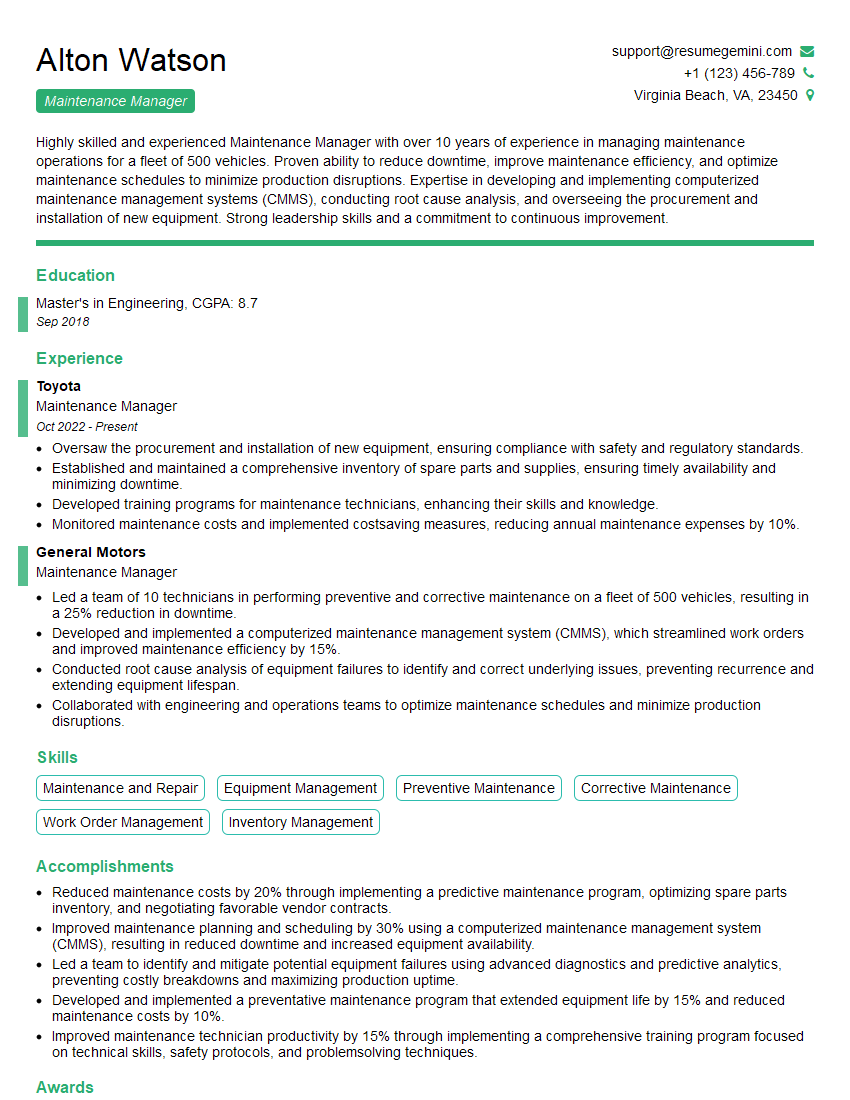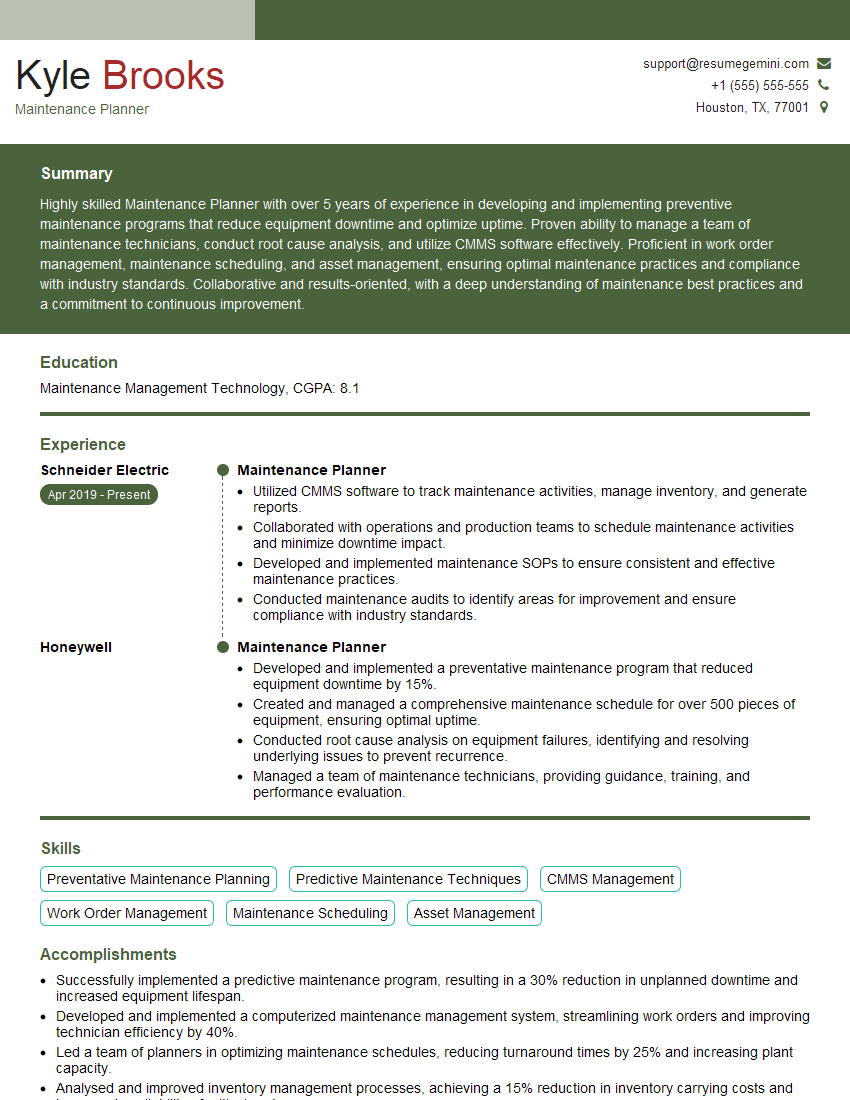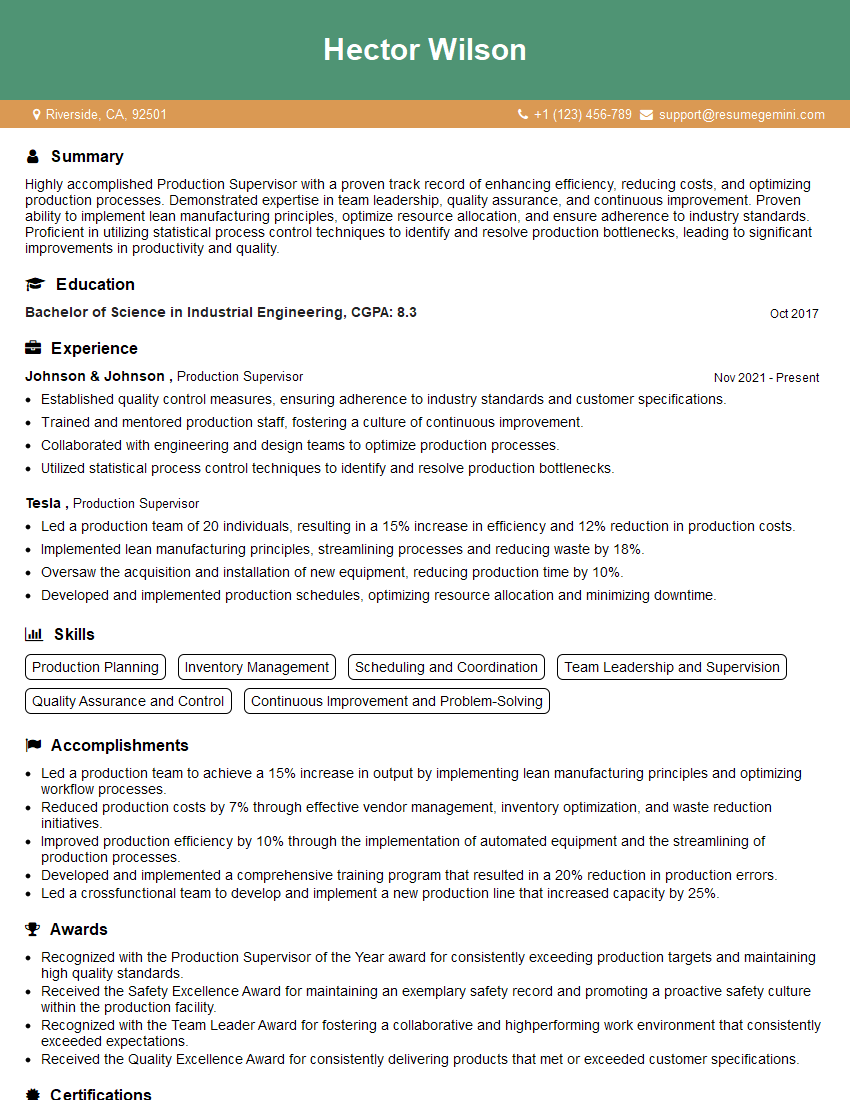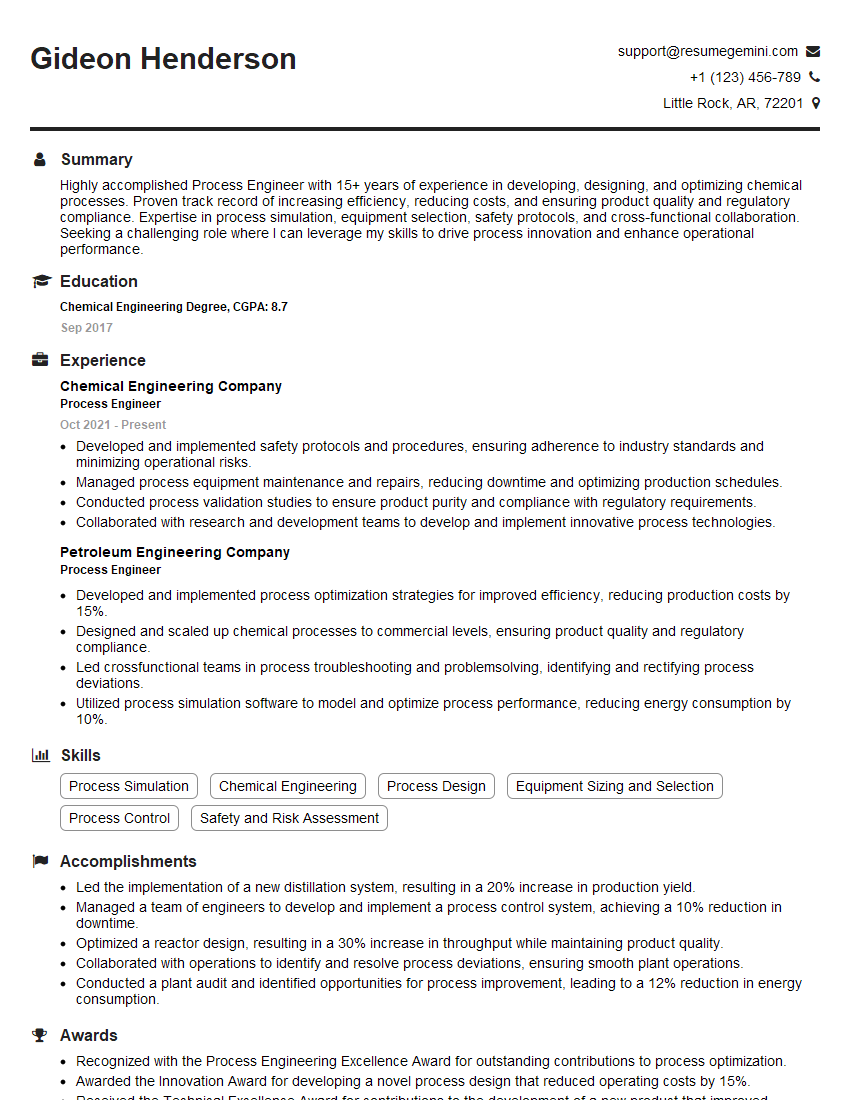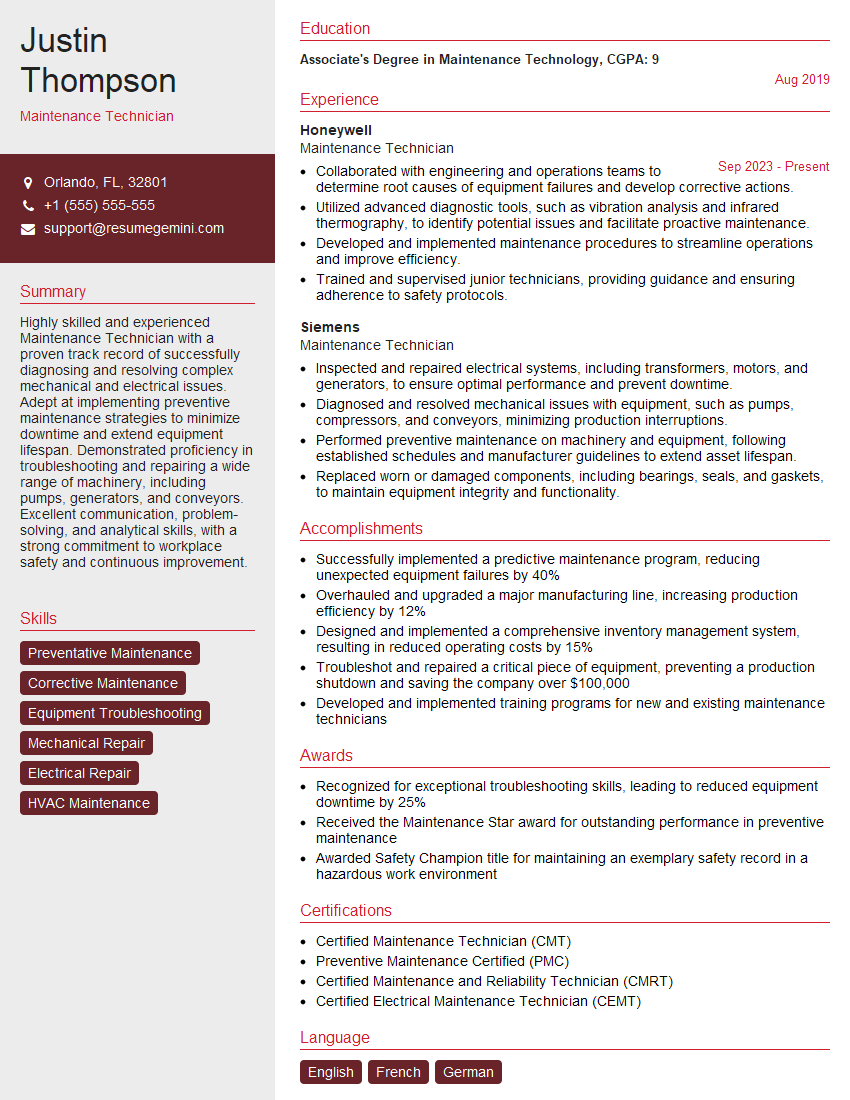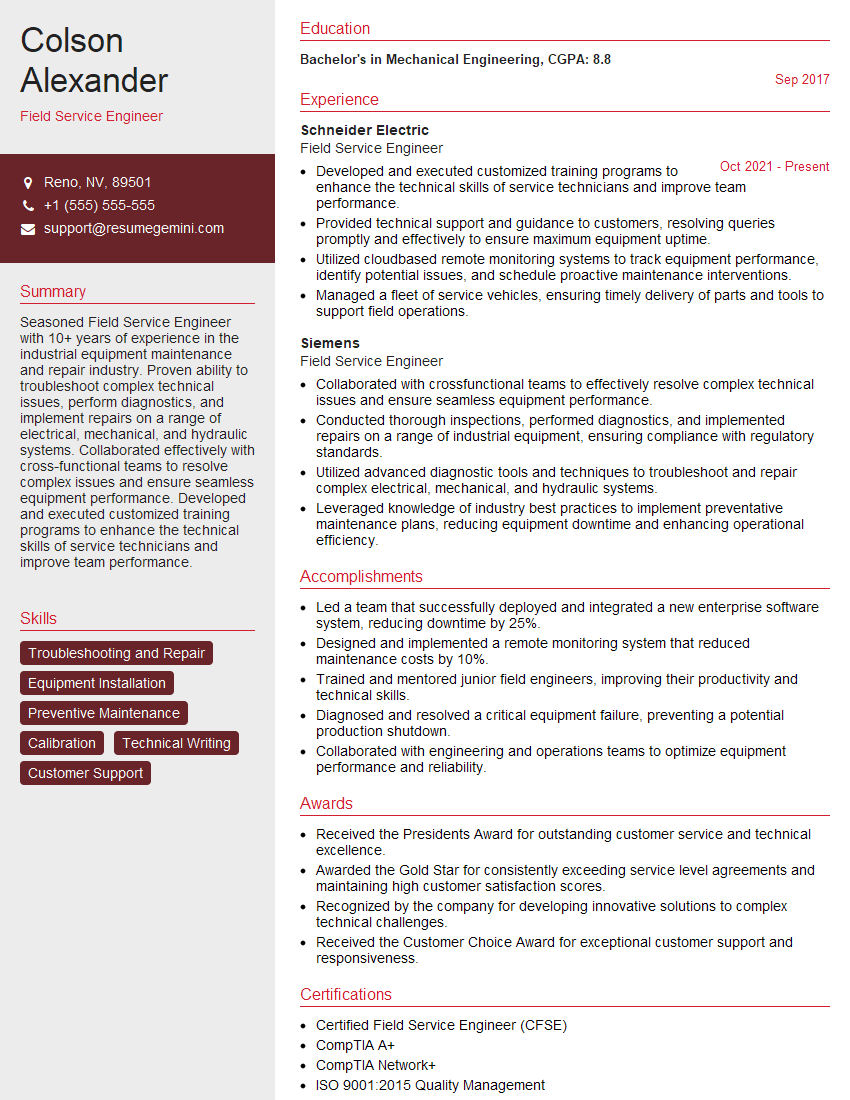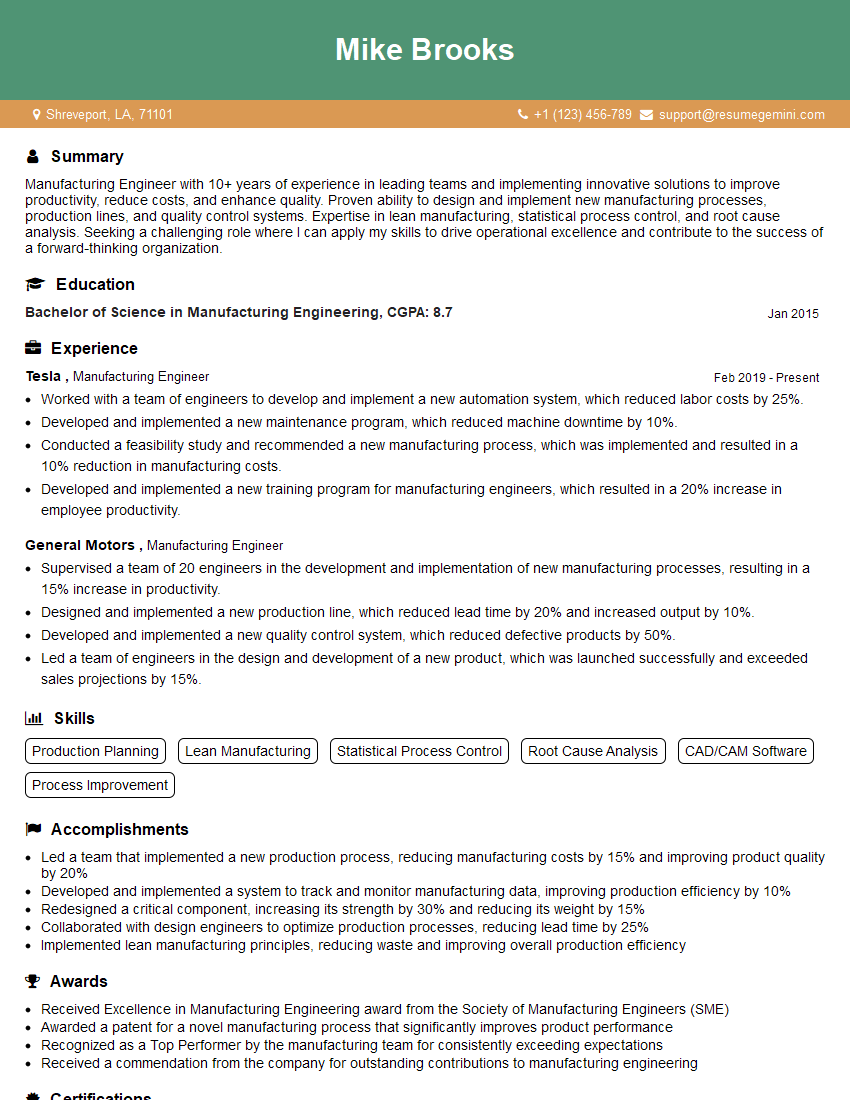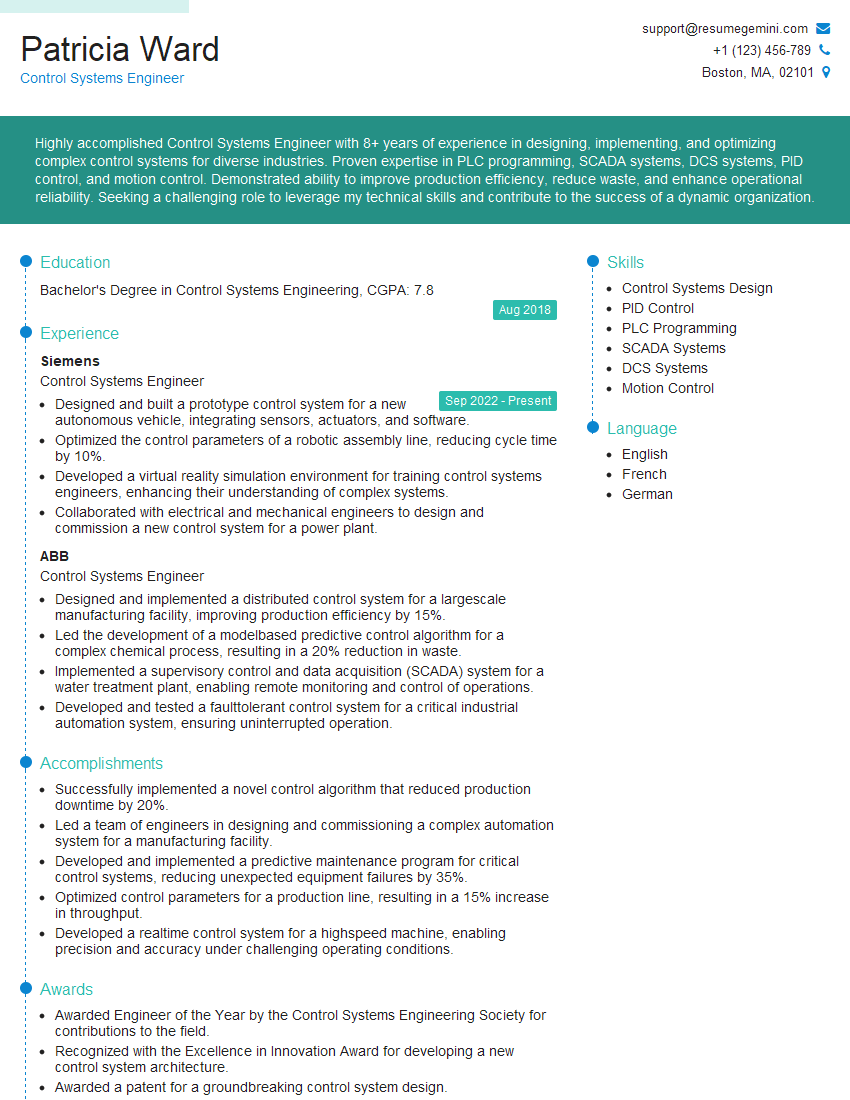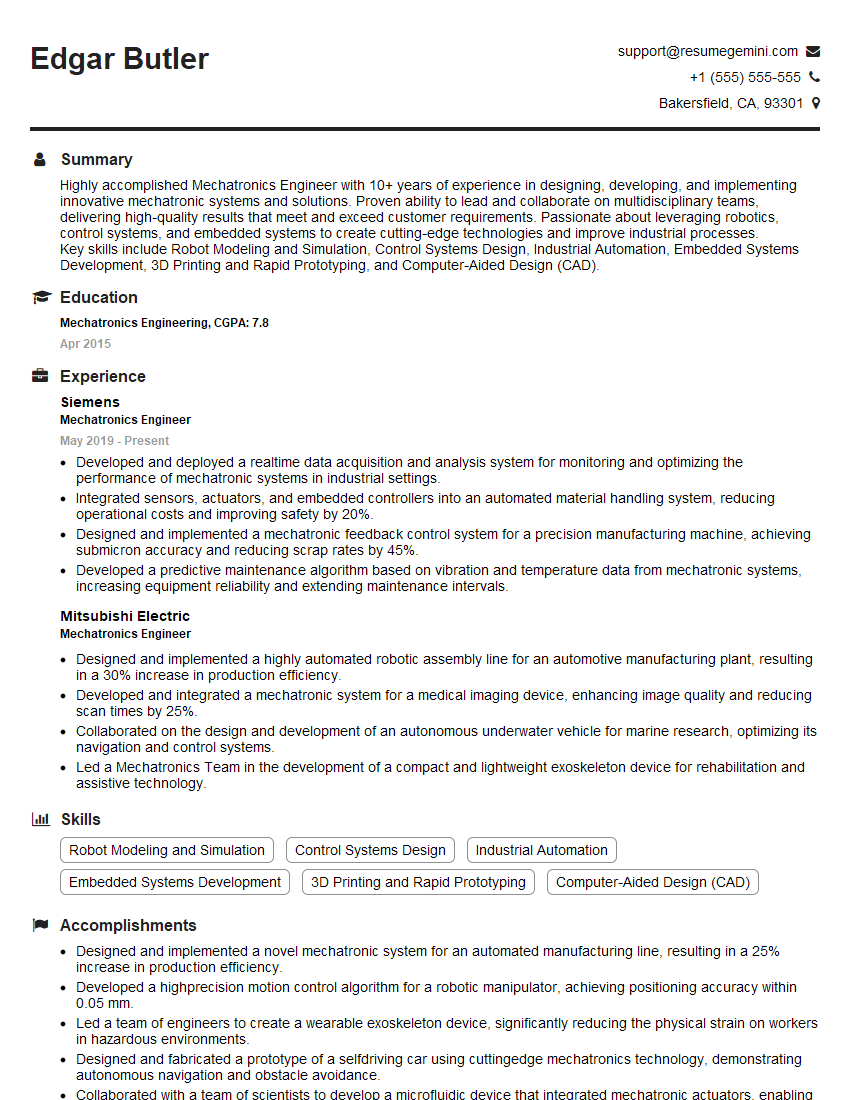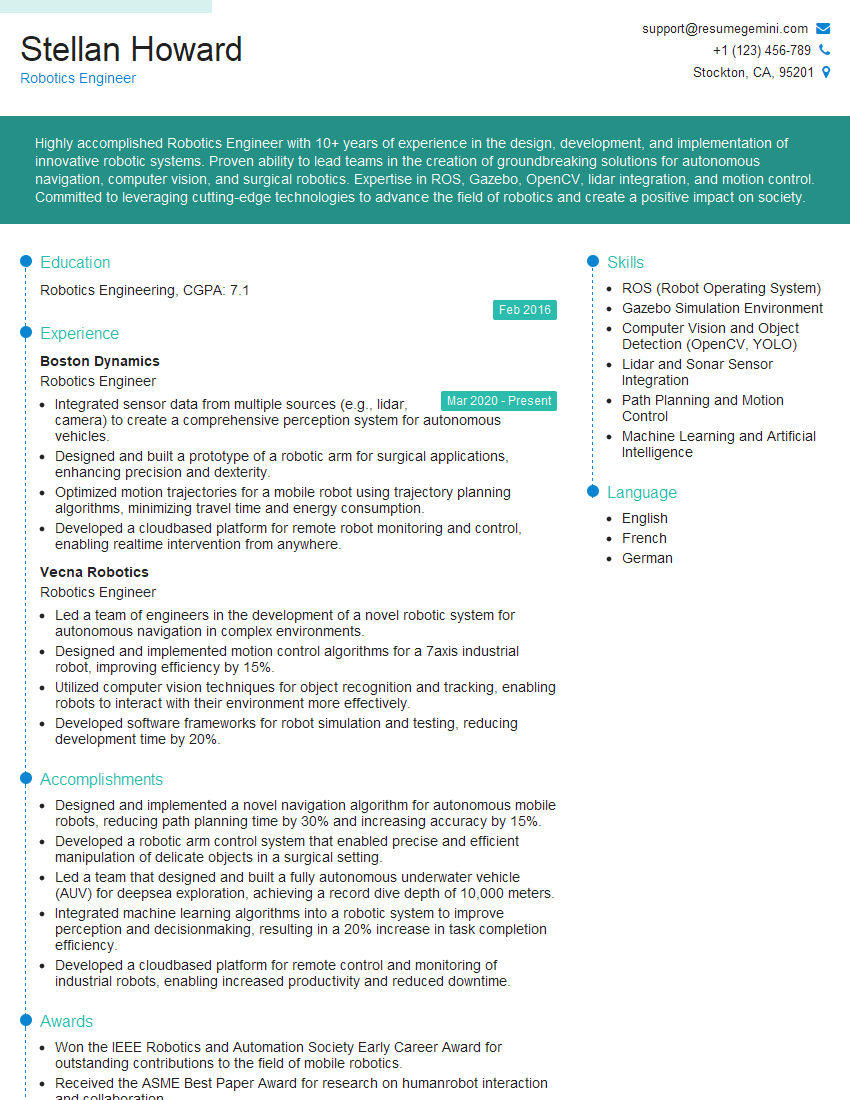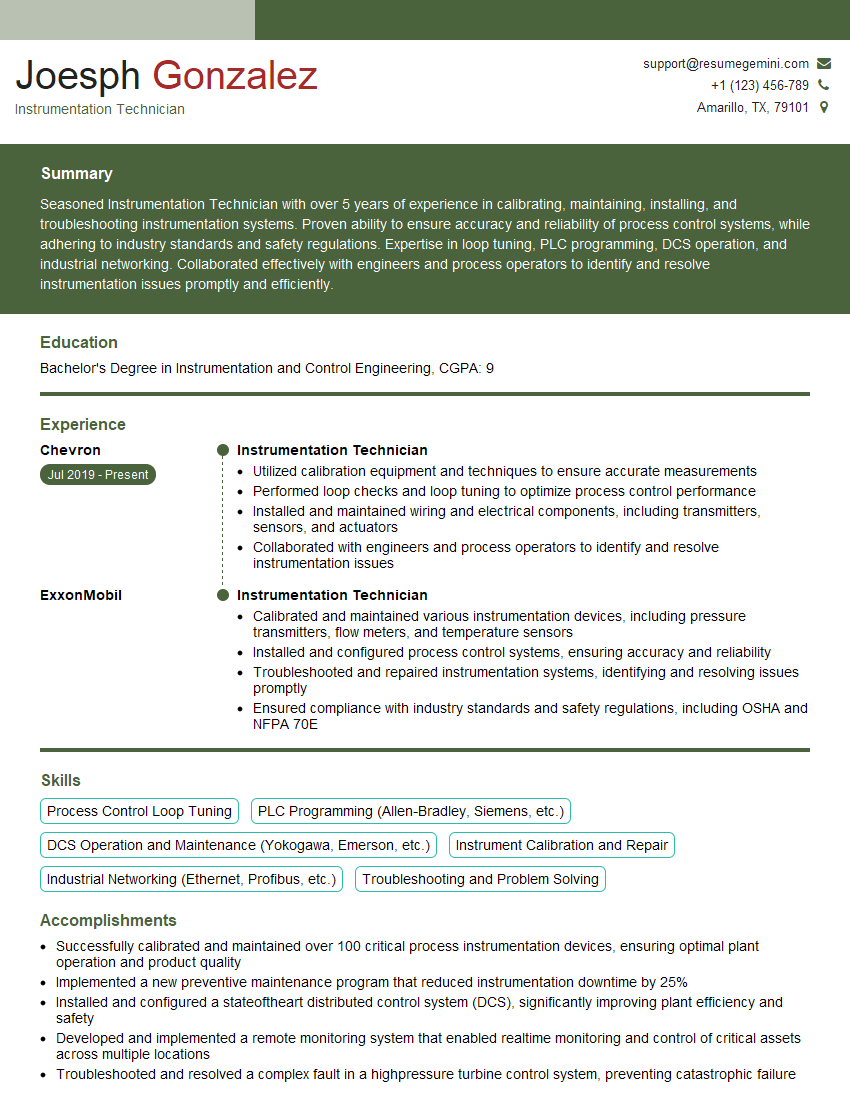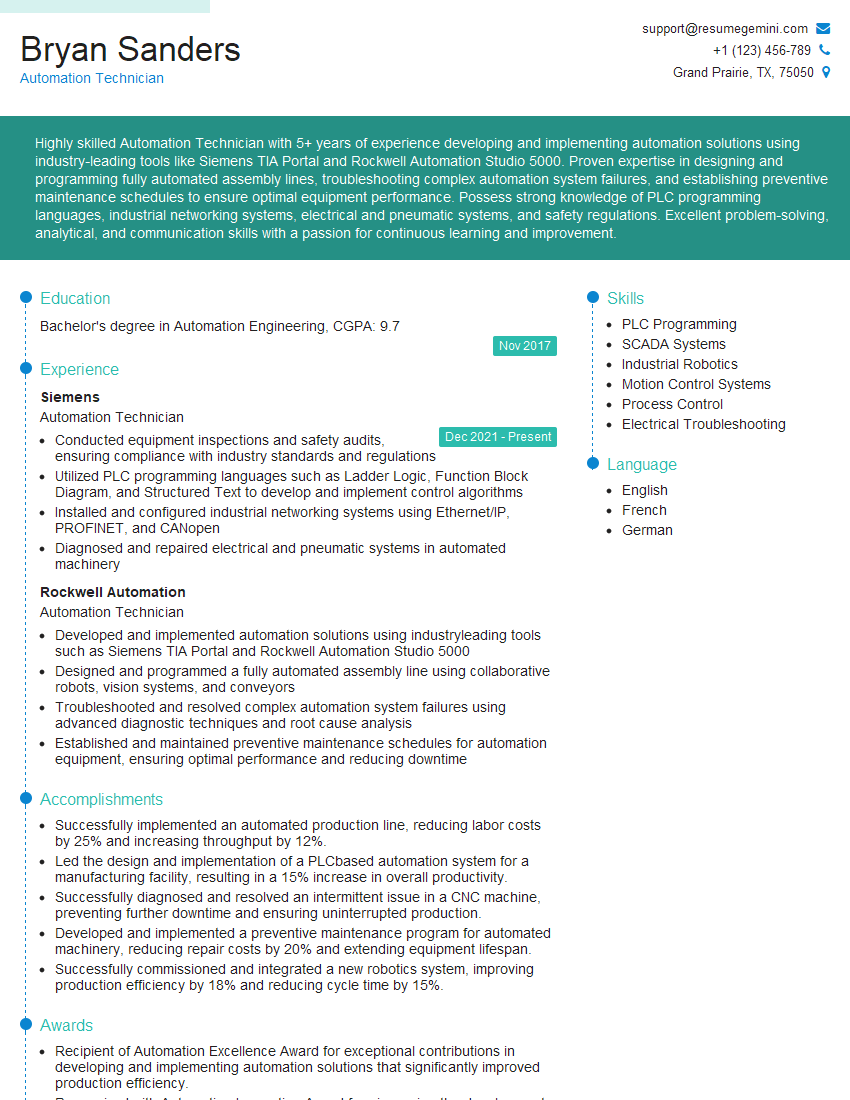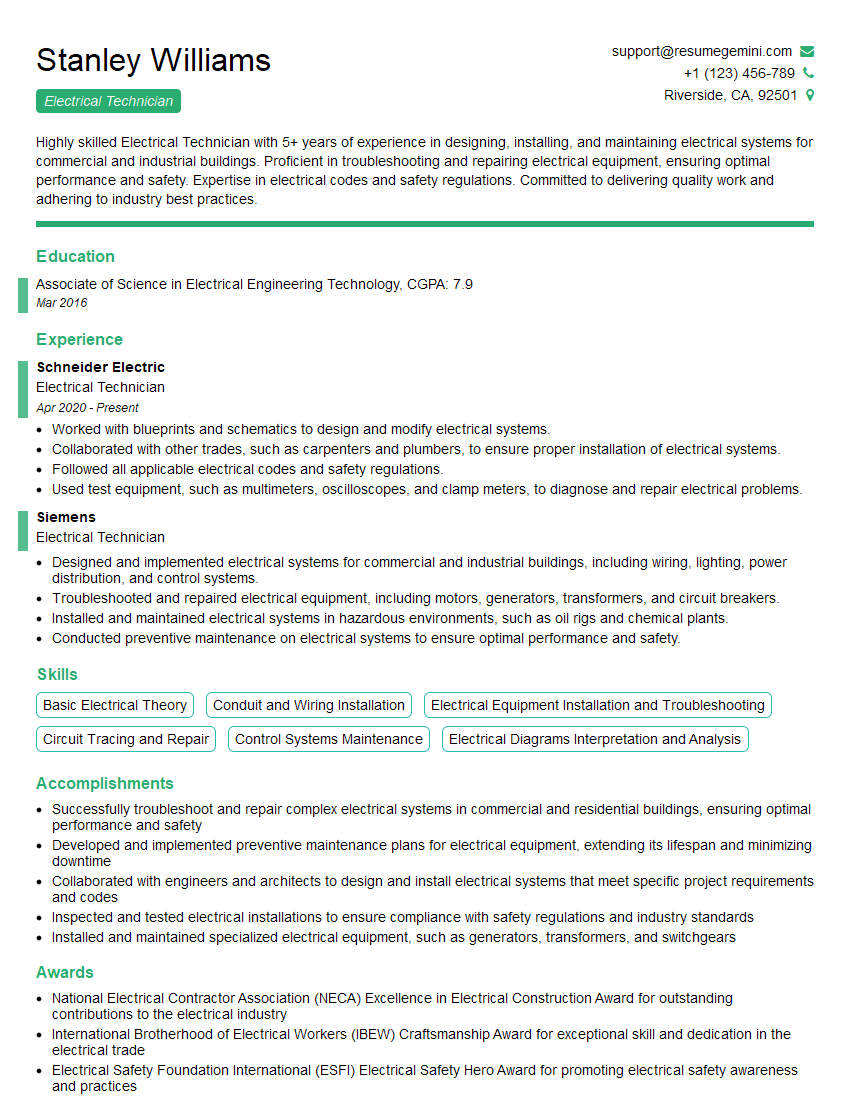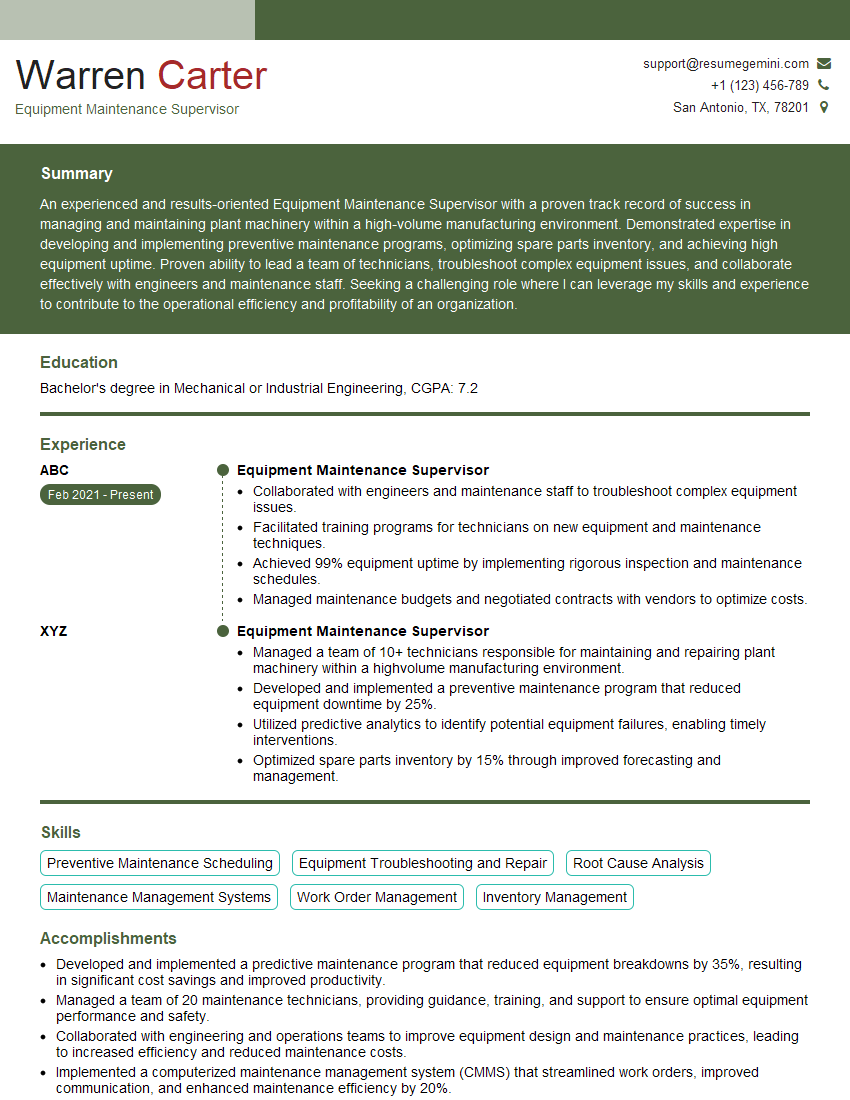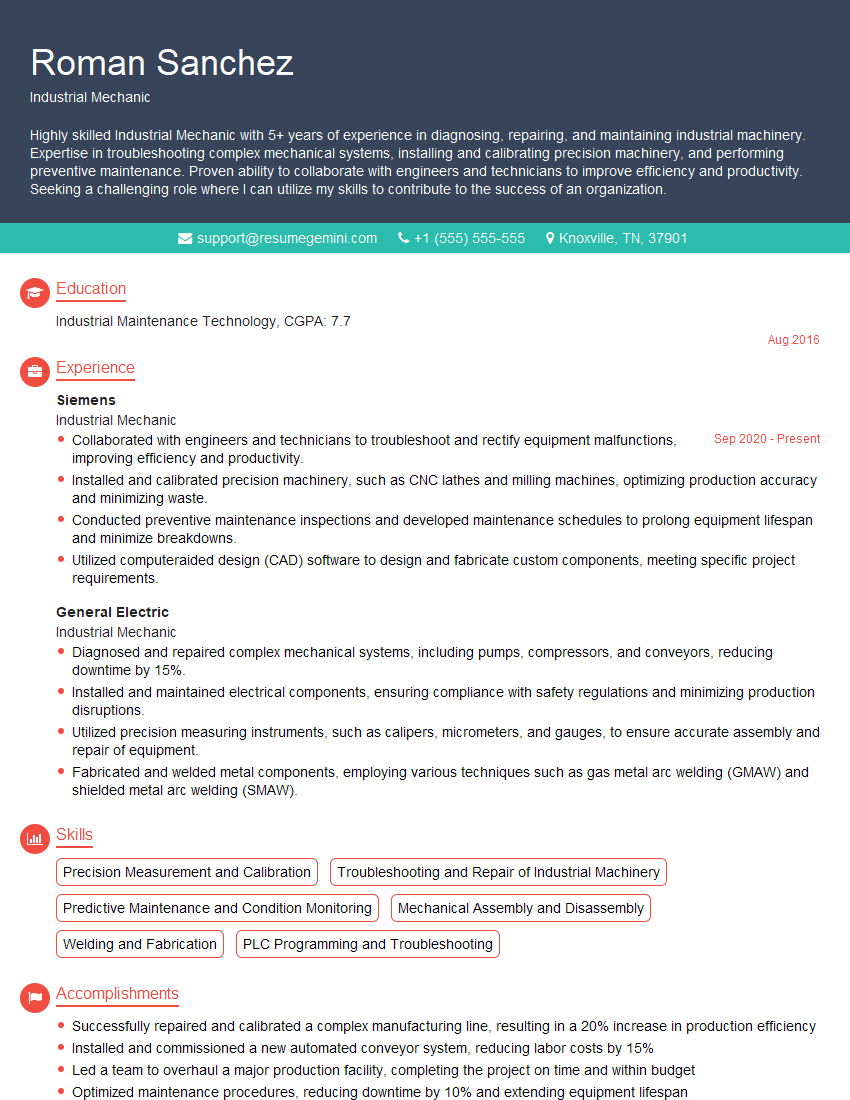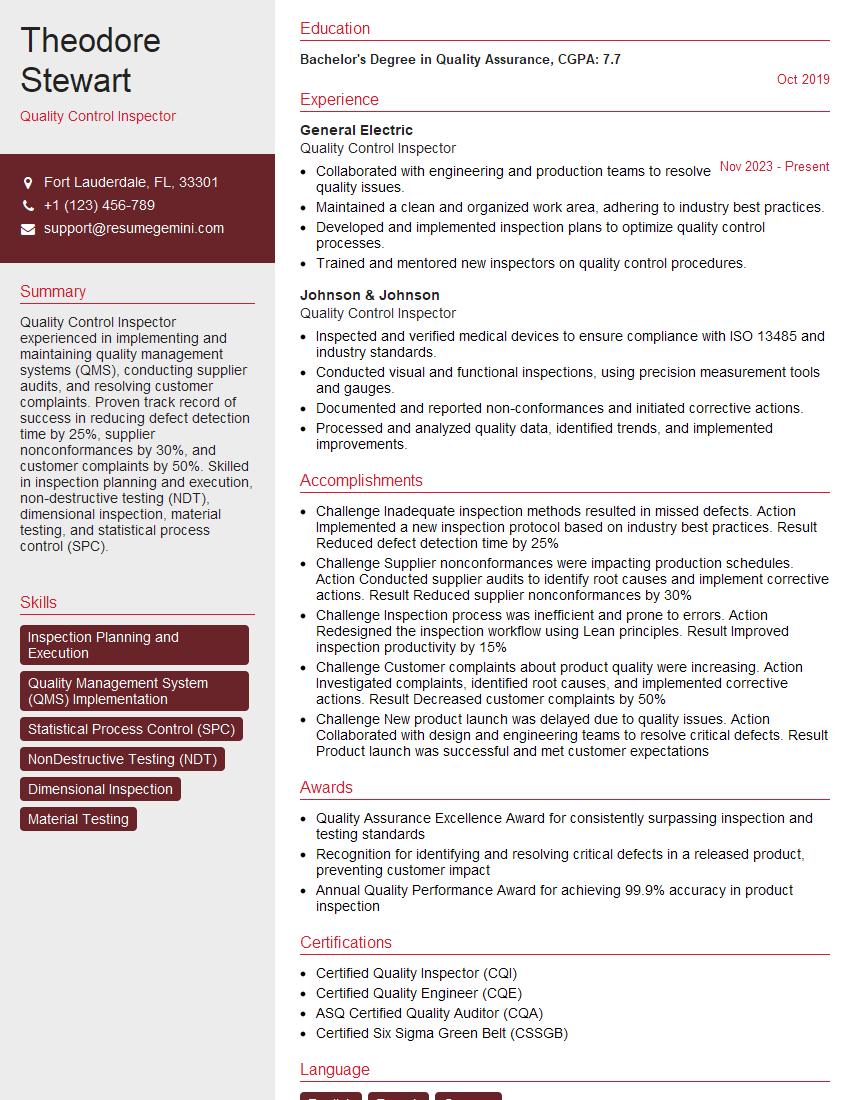Unlock your full potential by mastering the most common Ability to Identify and Resolve Machine Malfunctions interview questions. This blog offers a deep dive into the critical topics, ensuring you’re not only prepared to answer but to excel. With these insights, you’ll approach your interview with clarity and confidence.
Questions Asked in Ability to Identify and Resolve Machine Malfunctions Interview
Q 1. Describe your experience troubleshooting malfunctioning machinery.
My experience in troubleshooting malfunctioning machinery spans over ten years, encompassing a wide range of industrial equipment, from automated assembly lines to complex CNC machining centers. I’ve worked across diverse sectors, including manufacturing, packaging, and food processing. My approach always prioritizes safety and efficiency, focusing on identifying the root cause rather than just treating symptoms. I’ve successfully resolved numerous critical malfunctions, minimizing downtime and preventing potential safety hazards. For example, I once resolved a recurring jam in a high-speed bottling line by identifying a minute misalignment in the conveyor belt using a laser alignment tool. This prevented significant production losses and potential product damage.
Q 2. Explain the process you follow to diagnose a machine malfunction.
My diagnostic process is methodical and systematic. It begins with a thorough safety assessment, ensuring the machine is powered down and secured before any investigation. Then, I follow these steps:
- Gather Information: I start by collecting information about the malfunction. This includes reviewing error logs, observing the machine’s behavior, and interviewing operators to understand the circumstances leading to the failure.
- Visual Inspection: I conduct a visual inspection, checking for any obvious signs of damage, loose connections, leaks, or unusual wear. This often provides crucial clues.
- Systematic Testing: I systematically test individual components, isolating sections of the machine to pinpoint the source of the problem. This may involve using specialized testing equipment or simply observing the machine’s behavior under different conditions.
- Data Analysis: If necessary, I analyze machine data logs to identify patterns and trends that may indicate the root cause. This could involve analyzing sensor readings, pressure gauges, or temperature data.
- Root Cause Identification: Based on the gathered information and testing results, I identify the root cause of the malfunction. This is crucial for effective repair and preventing future occurrences.
- Implementation of Solution and Verification: I implement the appropriate solution, whether it’s a simple repair, replacement of a faulty component, or a more complex adjustment. Finally, I thoroughly test the machine to ensure the problem is resolved and the machine operates safely and effectively.
Q 3. What tools and techniques do you use to identify the root cause of a machine failure?
The tools and techniques I employ vary depending on the type of machine and the nature of the malfunction. However, my toolkit typically includes:
- Multimeters: To measure voltage, current, and resistance.
- Oscilloscope: To analyze electrical signals and identify intermittent problems.
- Infrared Thermometer: To detect overheating components.
- Vibration Analyzer: To identify mechanical imbalances or bearing failures.
- Laser Alignment Tools: For precise alignment of shafts and belts.
- Pressure Gauges: To measure pressure in pneumatic and hydraulic systems.
- Diagnostic Software: Many modern machines utilize diagnostic software that provides detailed error codes and system information.
- Technical Manuals and Schematics: Essential for understanding the machine’s design and operation.
Beyond tools, my techniques involve a combination of logical deduction, problem-solving skills, and experience in interpreting machine behavior and error messages. I’m proficient in using both preventative and reactive maintenance techniques.
Q 4. How do you prioritize multiple machine malfunctions?
Prioritizing multiple machine malfunctions requires a risk-based approach. I consider factors such as:
- Safety: Malfunctions that pose immediate safety risks are prioritized first. This includes situations involving electrical hazards, moving parts, or potential for material release.
- Production Impact: Malfunctions affecting critical production processes or resulting in significant downtime are given higher priority.
- Severity: The severity of the malfunction determines its priority. A minor issue can often wait while a catastrophic failure requires immediate attention.
- Repair Complexity: The time and resources required to repair a malfunction are considered. A quick fix might be prioritized over a complex repair that may require specialized expertise or parts.
I use a system to track and manage multiple malfunctions, often a simple spreadsheet or a dedicated CMMS (Computerized Maintenance Management System) to ensure that all issues are addressed efficiently and systematically.
Q 5. Describe a situation where you had to troubleshoot a complex machine issue.
I once encountered a complex issue with a high-speed automated packaging machine. The machine intermittently stopped, displaying a cryptic error code. Initial inspections revealed nothing unusual. Using the machine’s diagnostic software, I analyzed the error logs, which indicated inconsistencies in the timing signal between the PLC (Programmable Logic Controller) and the servo motor controlling the packaging arm. After examining the wiring harness and the PLC’s internal programming, I discovered a loose connection causing intermittent signal loss. By carefully tightening the connection and thoroughly testing the system, I resolved the issue, avoiding days of potential production downtime and significant financial losses.
Q 6. How do you document your troubleshooting process and findings?
Thorough documentation is crucial for efficient troubleshooting and preventative maintenance. I document my process and findings using a combination of methods:
- Detailed Written Reports: These reports include a description of the malfunction, the steps taken to diagnose the problem, the root cause identified, the solution implemented, and any preventative measures recommended. They are often accompanied by photographs or videos documenting the issue and the repair process.
- Machine Logs: I regularly review and record relevant information from the machine’s own data logs, providing a valuable historical record of machine performance and potential problems.
- CMMS (Computerized Maintenance Management System): Many companies use CMMS software to track maintenance activities, parts inventory, and repair histories. This facilitates efficient record-keeping and allows for easier trend analysis.
This thorough documentation ensures that problems can be efficiently resolved in the future, prevents recurrence of similar issues, and facilitates effective communication among maintenance personnel.
Q 7. What safety precautions do you take when troubleshooting machinery?
Safety is my paramount concern when troubleshooting machinery. I adhere strictly to the following safety precautions:
- Lockout/Tagout Procedures: Before commencing any troubleshooting, I ensure the machine is completely powered down and locked out, preventing accidental start-up.
- Personal Protective Equipment (PPE): I always wear appropriate PPE, including safety glasses, gloves, and protective clothing, to protect myself from potential hazards.
- Risk Assessment: I perform a thorough risk assessment before starting any work, identifying potential hazards and taking appropriate precautions.
- Proper Handling of Tools and Equipment: I use tools and equipment correctly and safely, following manufacturer’s instructions.
- Awareness of Hazardous Materials: I am aware of any hazardous materials present in or near the machine and take necessary precautions to avoid exposure.
- Following Company Safety Procedures: I always adhere to my company’s safety regulations and procedures.
By prioritizing safety in every aspect of the troubleshooting process, I ensure the safety of myself and others, minimizing the risk of accidents or injuries.
Q 8. How do you determine the most cost-effective repair solution for a machine malfunction?
Determining the most cost-effective repair solution involves a careful balancing act between repair cost, downtime cost, and the long-term reliability of the repair. It’s not simply about choosing the cheapest part; it’s about minimizing the total cost of ownership.
- Assess the Damage: Thoroughly diagnose the malfunction to pinpoint the root cause. A seemingly small issue might indicate a larger, underlying problem that requires more extensive repair.
- Gather Quotes: Obtain quotes from multiple vendors for both parts and labor. Compare not only the initial cost but also warranties and potential service contracts.
- Evaluate Downtime Costs: Calculate the cost of production loss while the machine is down. This often outweighs the repair cost itself, particularly for critical machinery.
- Consider Repair vs. Replace: If the repair cost approaches the cost of replacing the machine or a major component, replacement might be more economically viable in the long run. Factor in the remaining useful life of the machine.
- Prioritize Preventative Measures: The most cost-effective solution is often preventing the malfunction in the first place through regular maintenance and proactive identification of potential issues.
Example: Imagine a conveyor belt system malfunctioning due to a worn bearing. A simple bearing replacement might seem cheap, but if the root cause is misalignment, replacing the bearing without addressing the alignment will lead to further damage and more downtime later. The cost-effective solution would be to address the alignment issue, possibly involving more expensive adjustments but preventing future breakdowns.
Q 9. How do you handle situations where you are unable to immediately resolve a machine malfunction?
When faced with an unresolved malfunction, immediate escalation and clear communication are key. Panic is never the solution. My approach involves the following steps:
- Document Everything: Meticulously record observations, error codes, diagnostic test results, and any attempted repairs. This documentation aids in troubleshooting by others and may be crucial for warranty claims.
- Isolate the Problem: If possible, try to isolate the malfunction to a specific component or subsystem to limit the scope of the problem.
- Escalate to Experts: Consult with senior technicians, engineers, or the manufacturer’s support team for assistance. Provide them with the comprehensive documentation you’ve created.
- Implement Temporary Workarounds: While awaiting expert assistance, explore temporary solutions to minimize downtime. This could involve rerouting processes, using backup equipment, or employing manual workarounds.
- Communicate Effectively: Keep stakeholders informed of the situation, potential downtime, and the ongoing troubleshooting efforts. Transparency is vital to maintaining trust.
Example: If I encounter a complex PLC (Programmable Logic Controller) programming error, I would first document all inputs, outputs, and error messages. After exhausting my troubleshooting resources, I would escalate to a PLC specialist, providing the detailed documentation for quicker resolution.
Q 10. What experience do you have with preventative maintenance?
Preventative maintenance is the cornerstone of reliable machine operation. My experience encompasses developing and implementing preventative maintenance programs, including:
- Developing Checklists: Creating detailed checklists for routine inspections, encompassing lubrication, tightening bolts, cleaning, and functional testing.
- Scheduling Maintenance: Establishing a schedule based on manufacturer recommendations and operational data, ensuring timely performance of maintenance tasks.
- Implementing CMMS (Computerized Maintenance Management Systems): Using CMMS software to track maintenance activities, manage parts inventory, and generate reports on equipment performance and maintenance costs.
- Predictive Maintenance Techniques: Utilizing vibration analysis, oil analysis, and thermal imaging to anticipate potential failures before they occur.
- Training: Training other team members on preventative maintenance procedures and techniques to enhance collective knowledge and efficiency.
Example: In a previous role, I implemented a preventative maintenance program for a high-speed packaging line. This involved creating detailed checklists, scheduling lubrication every 200 hours of operation, and using vibration analysis to predict bearing failures. This significantly reduced downtime and increased the packaging line’s efficiency.
Q 11. How do you stay up-to-date with the latest technologies and troubleshooting techniques?
Staying current in this rapidly evolving field requires a proactive approach:
- Manufacturer Training: Participating in manufacturer-provided training courses to familiarize myself with the latest equipment features and troubleshooting techniques.
- Industry Publications and Conferences: Actively reading industry journals and attending conferences to learn about the latest advancements and best practices.
- Online Courses and Webinars: Enrolling in online courses and webinars focusing on specific technologies or troubleshooting strategies.
- Professional Networks: Networking with colleagues and experts within the field to share experiences and learn from their insights.
- Hands-on Practice: Continuously seeking opportunities to work with new technologies and apply learned knowledge in practical settings.
Example: To improve my skills with PLC programming, I recently completed an online course on advanced PLC programming techniques and attended a conference where I learned about new developments in industrial automation.
Q 12. Explain your understanding of different types of machine failures (mechanical, electrical, hydraulic, etc.).
Understanding different types of machine failures is critical for effective troubleshooting. Here’s a breakdown of common failure types:
- Mechanical Failures: These involve the physical components of the machine, such as bearings, gears, belts, shafts, and linkages. Common causes include wear and tear, fatigue, misalignment, and improper lubrication. Symptoms can include unusual noises, vibrations, decreased performance, or complete failure of the component.
- Electrical Failures: These relate to the electrical system of the machine, encompassing motors, sensors, wiring, control systems (PLCs, etc.), and power supplies. Causes include short circuits, open circuits, faulty wiring, damaged components, and power surges. Symptoms can include malfunctions, erratic behavior, power outages, and electrical arcing.
- Hydraulic Failures: These affect machines utilizing hydraulic systems for power transmission. Common issues include leaks in hoses and seals, pump failures, filter blockages, and contamination of hydraulic fluid. Symptoms can include low pressure, slow response, unusual noises, and fluid leaks.
- Pneumatic Failures: Similar to hydraulic failures but using compressed air instead of fluid. Problems include leaks in air lines, faulty valves, and compressor malfunctions.
Example: A repetitive clicking sound in a robotic arm might indicate a mechanical failure (worn bearing), while intermittent motor stalling might suggest an electrical fault (faulty wiring or power supply).
Q 13. Describe your experience with different diagnostic tools (e.g., multimeters, oscilloscopes).
I have extensive experience using various diagnostic tools, including:
- Multimeters: Used to measure voltage, current, resistance, and continuity in electrical circuits. Essential for identifying short circuits, open circuits, and faulty components.
- Oscilloscopes: Used to visualize electrical signals over time, helping to diagnose problems with timing, frequency, and signal integrity. Crucial for analyzing waveforms in control systems and motor drives.
- Vibration Analyzers: Used to measure and analyze vibrations in rotating machinery to detect imbalances, misalignments, and bearing defects.
- Thermal Imagers: Used to detect overheating components, which can indicate impending failures or existing problems such as loose connections or excessive friction.
- Logic Analyzers: Used to analyze digital signals and identify timing issues in digital control systems. Helpful in debugging PLC programs and other digital control logic.
Example: Using a multimeter, I once successfully pinpointed a short circuit in the wiring of a CNC machine’s motor control system, preventing further damage.
Q 14. How do you interpret machine error codes and diagnostic reports?
Machine error codes and diagnostic reports provide invaluable clues to malfunctions. My approach to interpreting them involves:
- Consult the Manual: The first step is always consulting the machine’s operation and maintenance manual to understand the meaning of specific error codes. These manuals typically provide detailed explanations and troubleshooting steps.
- Analyze the Context: Consider the operating conditions of the machine at the time the error occurred. Were there any unusual events or circumstances that might have contributed to the failure?
- Correlate with Diagnostic Data: Combine the error codes with data from other diagnostic tools (multimeter readings, oscilloscope waveforms, vibration analysis results). This helps to corroborate the error codes and pinpoint the root cause.
- Systematic Troubleshooting: Use a systematic approach to eliminate possible causes based on the error codes and other diagnostic information. This may involve checking connections, testing components, or performing more detailed diagnostic tests.
- Maintain a Log: Keep detailed records of the error codes, diagnostic data, and troubleshooting steps. This aids in future troubleshooting and potentially reveals patterns or trends that might indicate underlying problems.
Example: An error code indicating “low hydraulic pressure” on a press brake, combined with a low hydraulic fluid level, clearly suggests a leak in the hydraulic system. Further investigation with a thermal imager might pinpoint the leak’s location.
Q 15. What is your experience with Programmable Logic Controllers (PLCs)?
My experience with Programmable Logic Controllers (PLCs) spans over ten years, encompassing both programming and troubleshooting. I’m proficient in several PLC programming languages, including ladder logic (LD, AND, OR, OUT), function block diagrams (FBD), and structured text (ST). I’ve worked extensively with various PLC brands, such as Allen-Bradley, Siemens, and Mitsubishi, across a wide range of industrial applications. For instance, I once debugged a PLC program controlling a complex packaging line where a timing issue was causing intermittent jams. By carefully analyzing the ladder logic, I identified a misplaced timer instruction, corrected the code, and resolved the problem. This involved not only understanding the PLC’s programming but also its interaction with the sensors and actuators of the entire system.
Beyond programming, my troubleshooting skills involve using diagnostic tools to identify and solve hardware and software problems within the PLC itself. I can effectively utilize online and offline programming software for debugging and code optimization. I’m also adept at interpreting fault codes and using PLC documentation to diagnose issues efficiently.
Career Expert Tips:
- Ace those interviews! Prepare effectively by reviewing the Top 50 Most Common Interview Questions on ResumeGemini.
- Navigate your job search with confidence! Explore a wide range of Career Tips on ResumeGemini. Learn about common challenges and recommendations to overcome them.
- Craft the perfect resume! Master the Art of Resume Writing with ResumeGemini’s guide. Showcase your unique qualifications and achievements effectively.
- Don’t miss out on holiday savings! Build your dream resume with ResumeGemini’s ATS optimized templates.
Q 16. Describe your experience with hydraulic and pneumatic systems.
My expertise in hydraulic and pneumatic systems includes both preventative maintenance and troubleshooting. I’m familiar with various components, including pumps, valves, cylinders, actuators, and compressors. I understand the principles of fluid power and how these components interact to perform work. For example, I’ve resolved numerous leaks in hydraulic systems by identifying the source using pressure gauges and leak detection fluid. In another instance, I diagnosed a faulty pneumatic valve causing inconsistent actuator movement by carefully checking its air pressure and electrical signals.
I’m experienced in identifying issues such as air leaks in pneumatic systems, low hydraulic fluid levels, worn seals, and faulty sensors. My troubleshooting approach often involves systematically checking pressure, flow rates, and electrical signals to pinpoint the root cause of a malfunction. I’ve also used specialized tools like pressure transducers and flow meters to get precise measurements and understand the behavior of these systems in different operational states.
Q 17. How do you use schematics, diagrams, and manuals to troubleshoot machinery?
Schematics, diagrams, and manuals are essential for efficient troubleshooting. I use them like a roadmap, guiding my investigation and helping me visualize the system’s architecture. For instance, a pneumatic schematic will show me the flow of compressed air through valves and actuators, allowing me to trace a problem back to its origin. Electrical schematics help me trace wiring, identify sensor connections, and understand signal paths.
Manuals provide vital information on component specifications, operating procedures, and troubleshooting guides. I often cross-reference information from the schematic, the diagram, and the manual to build a comprehensive understanding of the problem. Think of it like assembling a puzzle; each document is a piece, and together they give you the complete picture. This systematic approach drastically reduces downtime and ensures the right fix the first time.
Q 18. Explain your understanding of vibration analysis in machine troubleshooting.
Vibration analysis is a powerful non-invasive technique to identify mechanical problems in machinery. Excessive vibration is often an indicator of bearing wear, imbalance, misalignment, or resonance issues. I use vibration analyzers to measure the frequency and amplitude of vibrations, which can pinpoint the source of the problem. For example, a high-frequency vibration might indicate a bearing defect, while a low-frequency vibration could point to a misalignment.
Understanding the different frequency ranges and their corresponding faults is crucial. I’m also adept at interpreting the results provided by the vibration analyzer, using tools such as Fast Fourier Transforms (FFT) to analyze the frequency spectrum. This allows me to make informed decisions about necessary repairs and preventative maintenance, preventing catastrophic failures and ensuring operational efficiency.
Q 19. How do you handle situations involving hazardous materials during troubleshooting?
Safety is paramount when dealing with hazardous materials. My approach involves a strict adherence to safety protocols, including wearing appropriate personal protective equipment (PPE) such as gloves, safety glasses, and respirators. Before starting any troubleshooting process, I thoroughly assess the risks associated with the materials involved and ensure I have the correct safety equipment and training. I am also familiar with the relevant safety data sheets (SDS) and emergency procedures.
For example, if I encounter a leak in a system containing a corrosive fluid, I’ll first isolate the affected area, then utilize the proper procedures and PPE to contain the spill and repair the leak. Proper ventilation is critical, and I make sure to maintain adequate airflow to prevent inhalation of hazardous vapors. In case of an emergency, I know how to effectively use emergency equipment and contact the appropriate personnel.
Q 20. What is your experience working with different types of machinery (e.g., CNC machines, robots, conveyors)?
I possess extensive experience working with various types of machinery, including CNC machines, robots, and conveyors. My experience with CNC machines involves troubleshooting both mechanical and programming issues, including tool changes, axis movements, and part accuracy. I’m familiar with different control systems and programming languages used in these machines.
My work with industrial robots includes programming, maintenance, and troubleshooting of robotic arms and end-effectors. This includes diagnosing issues with sensors, actuators, and control systems. With conveyors, I’ve addressed issues with motor drives, sensors, and belt tensioning. This broad experience enables me to adapt my troubleshooting techniques to a wide range of machinery and quickly identify and resolve the cause of the malfunction.
Q 21. How do you ensure the safety of yourself and others during the troubleshooting process?
Safety is my top priority. Before starting any troubleshooting, I conduct a thorough risk assessment to identify potential hazards. This might include electrical shock, moving parts, hazardous materials, or confined spaces. Based on this assessment, I select and use appropriate PPE and follow the relevant safety procedures. I always ensure the machine is properly locked out and tagged out before working on it, following the established lockout/tagout (LOTO) procedures. I also communicate clearly with my colleagues to make sure they are aware of my activities and potential hazards.
I follow all safety regulations and company policies. Moreover, I believe in a proactive approach to safety by regularly inspecting machinery and identifying potential problems before they escalate. For example, I would regularly check for wear and tear on components, which could lead to future safety issues. A safe working environment is not only important for productivity but is also crucial to prevent injuries and ensure a healthy workplace.
Q 22. Describe your experience with root cause analysis techniques.
Root cause analysis (RCA) is a systematic process for identifying the underlying causes of problems, not just the symptoms. My experience encompasses various techniques, including the 5 Whys, Fishbone diagrams (Ishikawa diagrams), and Fault Tree Analysis (FTA).
The 5 Whys is a simple iterative questioning technique. For example, if a machine jams repeatedly, we might ask: Why did it jam? (Insufficient lubrication). Why was there insufficient lubrication? (The lubrication pump failed). Why did the pump fail? (Bearing wear). Why was there bearing wear? (Lack of preventative maintenance). Why was there a lack of preventative maintenance? (Insufficient training for operators). This reveals the root cause: inadequate operator training leading to neglected maintenance.
Fishbone diagrams provide a visual representation of potential causes categorized into main branches (e.g., materials, methods, manpower, machines, environment, measurement). Each branch further branches down to specific causes. This allows for a more comprehensive brainstorming session involving multiple team members.
Fault Tree Analysis is a deductive approach using Boolean logic to determine the combination of events that lead to a particular failure. It’s particularly useful for complex systems where multiple factors can contribute to a malfunction. I’ve used FTA extensively in analyzing critical failures in automated production lines.
Q 23. What is your approach to preventing future occurrences of similar malfunctions?
Preventing future malfunctions requires a multi-pronged approach focusing on both immediate fixes and long-term preventative measures. My strategy involves:
- Corrective actions: Implementing the solutions identified through RCA. This might involve replacing faulty components, improving lubrication systems, or modifying operating procedures.
- Preventative maintenance: Establishing a rigorous schedule of routine inspections, lubrication, and component replacements. This is crucial in catching potential problems early and avoiding catastrophic failures.
- Operator training: Ensuring operators are properly trained on safe operating procedures, preventative maintenance tasks, and troubleshooting basic issues. This empowers them to identify and report problems before they escalate.
- Process improvements: Identifying and addressing systemic issues that may have contributed to the malfunction. This may include changes to workflow, material handling, or environmental controls.
- Data analysis: Using machine data (e.g., sensor readings, operating logs) to monitor performance and identify potential issues before they become major problems. This often involves implementing predictive maintenance strategies.
For instance, after a lubrication pump failure, we wouldn’t just replace the pump. We’d implement a system for automated lubrication level monitoring, improve operator training on lubrication checks, and perhaps even upgrade to a more robust pump design.
Q 24. How do you communicate technical information effectively to non-technical personnel?
Communicating technical information to non-technical personnel requires clear, concise language and effective visualization. I avoid technical jargon whenever possible, and I use analogies and metaphors to explain complex concepts in simpler terms. For instance, instead of saying “the actuator experienced a loss of pneumatic pressure,” I might say “the air pressure that moves the part failed.”
Visual aids like diagrams, flowcharts, and even short videos are invaluable in bridging the communication gap. I also actively encourage questions and ensure that the audience understands the key takeaways. A well-structured presentation or report, supported by clear visuals, ensures that all stakeholders understand the issue and its resolution, regardless of their technical expertise.
Q 25. Describe a time you had to work under pressure to resolve a machine malfunction.
During a critical production run, our primary packaging machine malfunctioned, causing a significant backlog. The issue stemmed from a sensor failure leading to inconsistent sealing, resulting in rejected products. This occurred during a peak season, putting immense pressure on us to resolve it quickly.
I immediately mobilized a team, focusing on a rapid RCA utilizing the 5 Whys technique and visual inspection. We discovered the sensor was faulty and had to replace it quickly. Simultaneously, we implemented a temporary workaround to minimize production downtime, diverting some product to a secondary packaging line. This involved prioritizing tasks, clear communication amongst team members, and decisive decision-making under pressure. We successfully restored full production within 4 hours, minimizing losses and ensuring customer commitments were met.
Q 26. How do you handle conflicting priorities when troubleshooting multiple machines?
When troubleshooting multiple machines simultaneously, I employ a prioritization matrix considering factors like the severity of the malfunction, potential production impact, and the urgency of repair. I use a system of assigning severity levels (critical, high, medium, low) to each malfunction to ensure I address the most impactful issues first.
For instance, if one machine is causing a complete production halt (critical), I focus on that first, while potentially delegating less urgent issues (medium or low) to other technicians or scheduling their repair for later. Clear communication is paramount here, to keep stakeholders updated on the progress of each repair and to manage expectations.
Q 27. What are your salary expectations for this role?
My salary expectations are commensurate with my experience and skills, and align with the industry standard for a senior-level position in this field. I am open to discussing a specific compensation package based on the details of the role and the company’s compensation structure. I’m more interested in a challenging and rewarding opportunity than a specific number.
Key Topics to Learn for Ability to Identify and Resolve Machine Malfunctions Interview
- Understanding Machine Operation: Thoroughly grasp the mechanical, electrical, and/or software components of the specific machines relevant to the role. This includes knowing how each part functions and interacts with others.
- Troubleshooting Methodologies: Practice systematic approaches like the 5 Whys, fault trees, and process of elimination to diagnose malfunctions efficiently. Be prepared to explain your preferred methods and why they are effective.
- Diagnostic Tools and Techniques: Familiarize yourself with common diagnostic tools (multimeters, oscilloscopes, diagnostic software) and their proper usage in identifying root causes. Demonstrate your ability to interpret data from these tools.
- Preventive Maintenance and Predictive Analysis: Show your understanding of proactive maintenance strategies to minimize malfunctions. Discuss your experience with predictive maintenance techniques and data analysis for anticipating issues.
- Safety Procedures and Regulations: Highlight your awareness and adherence to safety protocols when handling machinery and troubleshooting malfunctions. This demonstrates responsibility and a commitment to a safe work environment.
- Repair and Restoration Techniques: Be ready to discuss your experience with repairing or replacing faulty components. Focus on your ability to perform repairs efficiently and effectively, minimizing downtime.
- Documentation and Reporting: Explain your approach to documenting troubleshooting steps, repairs made, and lessons learned. Clear and concise documentation is crucial in maintaining efficient operations.
- Problem-Solving and Critical Thinking: Emphasize your analytical skills and ability to think critically under pressure to efficiently resolve complex machine malfunctions.
Next Steps
Mastering the ability to identify and resolve machine malfunctions is crucial for career advancement in many technical fields. It demonstrates your problem-solving skills, technical expertise, and commitment to operational efficiency. To significantly boost your job prospects, it’s vital to craft an ATS-friendly resume that effectively highlights these skills. ResumeGemini is a trusted resource to help you build a professional and impactful resume that gets noticed. We provide examples of resumes tailored to showcase expertise in identifying and resolving machine malfunctions to help you get started. Invest in your future – build a compelling resume today.
Explore more articles
Users Rating of Our Blogs
Share Your Experience
We value your feedback! Please rate our content and share your thoughts (optional).
What Readers Say About Our Blog
This was kind of a unique content I found around the specialized skills. Very helpful questions and good detailed answers.
Very Helpful blog, thank you Interviewgemini team.
